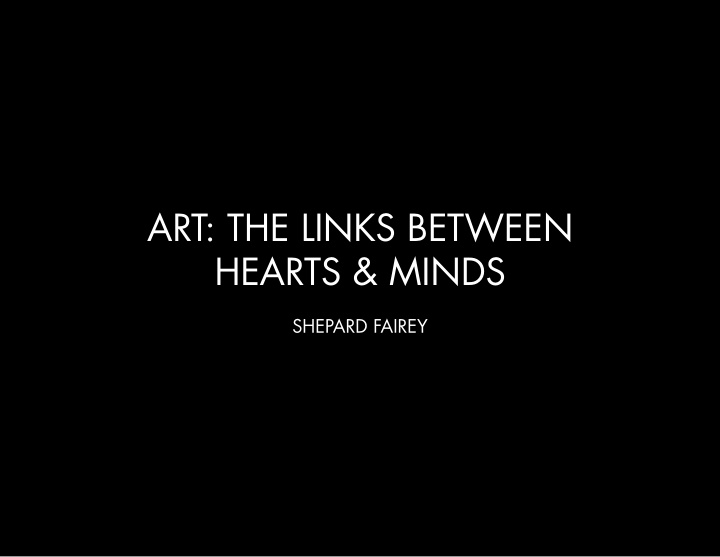



ART: THE LINKS BETWEEN HEARTS & MINDS SHEPARD FAIREY
While I’m best known for OBEY and HOPE, I’ve been making sociopolitical and environmentalist statements through art since I was a college student in the late ‘80s and early ‘90s. Along the way, I’ve developed these 6 philosophies for making an impact through art – 1. Start on the outside, work toward the inside 2. Make the invisible visible 3. Get to the root – and dig it up 4. Art can’t be either evocative or provocative – it has to be both 5. Sometimes the most powerful weapon against propaganda is absurdity 6. Push products, not just pledges (Desire not just Guilt)
The first sticker I ever put in public was created as a joke; I definitely wasn’t planning to change anyone’s hearts or minds with it. But I quickly realized that people who saw it were forced to think – not in spite of its lack of inherent meaning but because of it. So I came to learn about phenomenology, and the idea that we define objects not by their innate properties but by how we experience them. Context matters: not just where you position your art in the world, but where you position yourself.
1. START ON THE OUTSIDE, WORK TOWARD THE INSIDE
Working outside-in means building partnerships with like-minded groups that can bring your message and your image to a broader audience (in my early career it was the Sierra Club, under the leadership of my friend Adam Werbach). Iconography is a powerful way to convey an emotional appeal, playing off of the deep-seated connotations of recognizable imagery.
2. MAKE THE INVISIBLE VISIBLE When Rachel Carson’s book Silent Spring was released in 1962, it not only highlighted the harmful effects of DDT to ecosystems, but also the misinformation being spread by the chemical industry and its political allies. The title Silent Spring was intended to force readers to contemplate springtime without the sounds of songbirds – a jarring picture, but also a reminder that our emotional connection to our environment is mainly aesthetic. If we stay oblivious to ecological destruction until we notice the aesthetics change, by then it will be too late.
In order to stir people’s emotions and get them to think more critically about our eco- logical wellbeing, we need to paint the picture. We need to turn up the volume on the silence; we need to make the invisible visible.
3. GET TO THE ROOT – AND DIG IT UP The very best thing we can do in this country for climate stability, for the protection of natural resources and wildlife, for the quality of our air and water, for the implementation of sustainable fuels and smarter growth, is campaign finance reform.
Our politics also have ramifications for ecological systems abroad, where weapons like those that use depleted uranium are killing people long after those bombs were dropped. The rates of cancer, birth defects and infant mortality in Fallujah, Iraq since 2005 are higher than those in Hiroshima and Nagasaki after 1945.
The root of the problem is not just the politics of capitalism, it’s also the convenience culture mentality we have in this country. It’s not an easy thing to depict, but again it’s a matter of making the invisible more visible, so I try to highlight the smugness of American exceptionalism and amplify the irony of it.
When you experience art in the moment, it’s an emotional connection, but when you walk away from it, the thing you remember is how it shifted your perspective and made you think about the conflict inherent in it.
4. ART CAN’T BE EITHER EVOCATIVE OR PROVOCATIVE IT HAS TO BE BOTH My favorite art allows viewers some escape from their lives and a connection with something outside themselves, but at the same time encourages thought and engagement – so I’ve always sought to capture that balance of evocative and provocative.
I don’t know if anyone who actually owns a Hummer has ever bought this poster, and I don’t know if they’d appreciate the irony of it. The troubling thing about fossil fuel is that it in itself will probably always be cheaper and easier to get than renewable fuel, but the costs it creates in other areas due to climate instability are staggering. The U.S. federal government spent over $100 billion in 2012 alone dealing with the consequences of extreme weather (droughts, storms, floods and forest fires), more than it spent on education or transportation.
5. SOMETIMES THE MOST POWERFUL WEAPON AGAINST PROPAGANDA IS ABSURDITY The challenge in spreading these truths is not just that they’re inconvenient; it’s also that they’re unsexy. It’s much easier to get people to pay attention to humor than cold, hard facts, and the most bountiful, renewable source of humor is the propaganda machine that tries to put a blithe veneer on toxicity.
6. PUSH PRODUCTS, NOT PLEDGES (DESIRE NOT JUST GUILT) I’ve always believed that commerce and social good are not mutually exclusive. I believe in conscientious capitalism. Greed can make commerce an erosive force, but commerce can support philanthropy. Pure philan- thropy has certainly kept lots of important non-profits in operation, but I don’t believe donations are the only way to raise money for causes. Proceeds from this poster of a Rocky Shoals Spider Lily, an endangered flower along the coastal plains of South Carolina and Georgia, went directly toward efforts to save it from extinction.
This poster not only helped promote the film 180° South , it also raised awareness and funds for the filmmakers’ mission to prevent the construction of hydroelectric dams that would destroy pristine Patagonian wilderness. -SHEPARD FAIREY
Recommend
More recommend